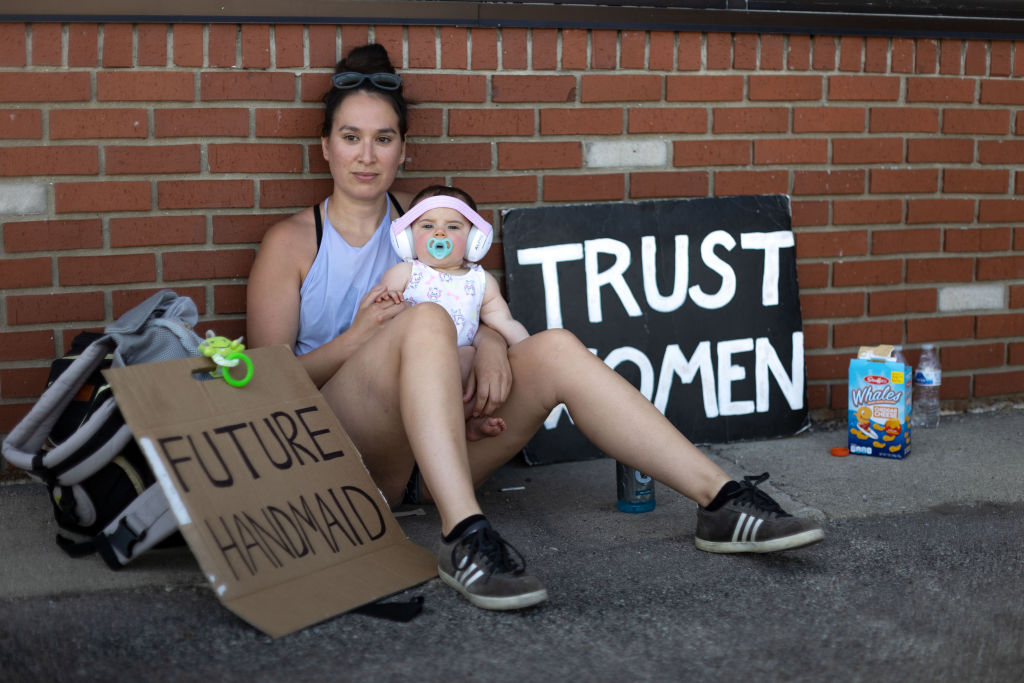By a 14-point margin, Ohioans rejected a proposal that would have made it harder to pass future constitutional amendments—including one in November about abortion rights.

Update Tuesday, Aug. 8, at 8:55 p.m. PT: Ohio voters resoundingly rejected Issue 1, which would have made it harder to amend the state constitution—including a ballot measure that seeks to ensure the constitutional right to abortion, which will now officially appear on the ballot for Ohio voters in November. With all precincts reporting, and 58,000 absentee and provisional ballots left to be counted, the measure was failing by a margin of 57 percent to 43 percent.
Voter turnout in this hastily scheduled special election in an off-year, was nearly double that of the 2022 state elections—in which candidates for governor and U.S. senator were on the ballot, which typically helps to spur higher turnout.
President Joe Biden hailed the result: “This measure was a blatant attempt to weaken voters’ voices and further erode the freedom of women to make their own healthcare decisions. Ohioans spoke loud and clear, and tonight democracy won.”
Update Monday, Aug. 7, at 8:25 a.m. PT: Ohio voters are proving highly motivated to cast their ballot in the state’s ongoing special election, which ends Aug. 8. Early voting has already seen record-breaking turnout. “This is gubernatorial-level turnout,” said Regine Johnson, deputy director of the board of elections in Stark County.
The election tasks voters to decide whether or not to make it harder to pass future constitutional amendments in the state, by raising the threshold to pass an amendment from a simple majority to 60 percent. The Republican-led Issue 1 is a direct response to the citizen-led abortion rights ballot initiative.
“The Republicans know that the amendment is going to pass, so they’re trying to make as hard as possible,” said Kathy Spillar, executive director of Feminist Majority Foundation. “Anything to derail the drive to women’s full autonomy.”
Ohioans: Polls are open on Tuesday, Aug. 8, from 6:30 a.m.–7:30 p.m. Sign up to be a poll worker. Find your polling place.

It’s official: Abortion rights advocates in Ohio have met the signature requirement to place a measure on the Nov. 7, 2023, ballot that would codify abortion rights in the state constitution.
The proposed constitutional amendment reads: “Every individual has a right to make and carry out one’s own reproductive decisions, including but not limited to decisions on contraception, fertility treatment, continuing one’s own pregnancy, miscarriage care and abortion.”
Petitioners received a total of 495,938 valid signatures (exceeding the required minimum of 413,446) collected from 55 counties in Ohio (exceeding the minimum requirement of 44).
Almost 60 percent of Ohio voters back the abortion rights amendment—including 81 percent of Democrats, 70 percent of independents, and 85 percent of independent women—according to a recent USA TODAY Network/Suffolk University poll.
Before the amendment gets in front of voters, though, it faces one more unique obstacle: an Aug. 8 election, where voters are tasked to decide if future constitutional amendments will need to meet a threshold of 60 percent support, rather than 50 percent (or a simple majority). The measure—Ohio Issue 1, the 60 Percent Vote Requirement to Approve Constitutional Amendments Measure—would also mandate that signatures come from every single county in the state, meaning one county could band together to stop a measure from progressing across the entire state.
- A yes vote supports amending the state constitution to increase the threshold to 60 percent.
- A no vote rejects the change, maintaining that a simple majority vote is required for voters to approve new constitutional amendments.
A poll this week showed 57 percent of Ohio voters do not support Issue 1, and just 27 percent were in favor. (About 17 percent were undecided.)
Issue 1 is an initiative led by Republican legislators. House Minority Leader Allison Russo (D) said it would “take away power from people and put it more firmly into politicians’ hands.”
If it passes, “it will be nearly impossible to pass citizen-initiated constitutional amendments protecting reproductive rights, or fair electoral maps, or pro-voter policies like automatic voter registration,” wrote attorney Susie Hwang. “Gaining steam is a November 2024 ballot measure that would remedy the state’s notoriously gerrymandered voting maps. … No wonder Republicans are panicked. They smell defeat, so they’re scrambling to change the rules of the game.”
Early voting on Issue 1 is already in progress. Advocates have been worried about turnout in an election held in an off year at the end of the summer, but early voter turnout numbers have already showed a “five-fold increase” compared to last year’s August election, according to Secretary of State Frank LaRose. (Ohioans, register to vote, check your registration status and explore nonpartisan resources on the Aug. 8 ballot issue.)
“Every person deserves respect, dignity and the right to make reproductive healthcare decisions, including those related to their own pregnancy, miscarriage care, and abortion free from government interference,” said Lauren Blauvelt and Dr. Lauren Beene, both on the executive committee of Ohioans United for Reproductive Rights.
“I think folks are really paying attention,” said Heather Shumaker, director of state abortion access for the National Women’s Law Center, which supports the amendment.
Including Ohio, 26 states allow citizens to propose new statutes or constitutional amendments. “Ballot measures have emerged as one of the most promising strategies to preserve abortion access,” said Shumaker.
Up next:
U.S. democracy is at a dangerous inflection point—from the demise of abortion rights, to a lack of pay equity and parental leave, to skyrocketing maternal mortality, and attacks on trans health. Left unchecked, these crises will lead to wider gaps in political participation and representation. For 50 years, Ms. has been forging feminist journalism—reporting, rebelling and truth-telling from the front-lines, championing the Equal Rights Amendment, and centering the stories of those most impacted. With all that’s at stake for equality, we are redoubling our commitment for the next 50 years. In turn, we need your help, Support Ms. today with a donation—any amount that is meaningful to you. For as little as $5 each month, you’ll receive the print magazine along with our e-newsletters, action alerts, and invitations to Ms. Studios events and podcasts. We are grateful for your loyalty and ferocity.





